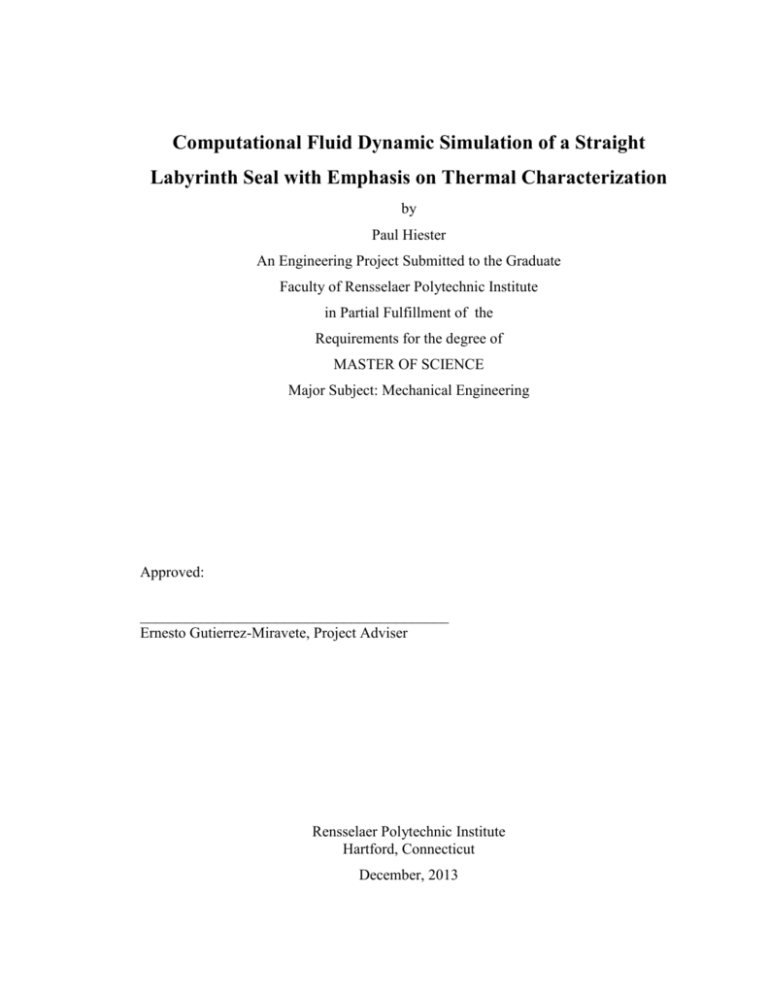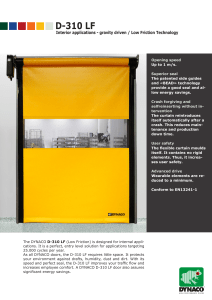
Computational Fluid Dynamic Simulation of a Straight
Labyrinth Seal with Emphasis on Thermal Characterization
by
Paul Hiester
An Engineering Project Submitted to the Graduate
Faculty of Rensselaer Polytechnic Institute
in Partial Fulfillment of the
Requirements for the degree of
MASTER OF SCIENCE
Major Subject: Mechanical Engineering
Approved:
_________________________________________
Ernesto Gutierrez-Miravete, Project Adviser
Rensselaer Polytechnic Institute
Hartford, Connecticut
December, 2013
Table of Contents
List of Tables .................................................................................................................... iv
List of Figures .................................................................................................................... v
List of Symbols ................................................................................................................ vii
Acknowledgements........................................................................................................... ix
Abstract .............................................................................................................................. x
1. Introduction and Background ...................................................................................... 1
2. Labyrinth Seal Rotor and Stator Geometry ................................................................. 4
3. CFD Boundary Condition Setup .................................................................................. 7
4. CFD Grid Independence Study.................................................................................... 9
5. 2D Axisymmetric CFD Analysis with Various Seal Clearances ............................... 12
5.1
Fluent CFD Setup and Solution Convergence ................................................. 12
5.2
Solution Post-Processing and Discussion ........................................................ 15
5.3
Leakage and Windage Calculation and Discussion ......................................... 17
5.4
Leakage and Windage Results Summary......................................................... 19
6. Seal Convection Heat Transfer Characterization ...................................................... 24
6.1
Heat Transfer with Viscous Heating ................................................................ 24
6.2
Heat Transfer without Viscous Heating ........................................................... 27
6.3
Results Summary and Discussion .................................................................... 28
7. 3D CFD Analysis with Various Honeycomb Seal Land Geometry .......................... 30
7.1
Geometry Definition ........................................................................................ 30
7.2
3D Solution Post-Processing and Discussion .................................................. 33
8. Conclusions................................................................................................................ 37
9. References.................................................................................................................. 38
10. Appendix.................................................................................................................... 39
ii
© Copyright 2013
by
Paul Hiester
All Rights Reserved
iii
List of Tables
Table 1 CFD geometry: Rotor, stator and land dimensions .............................................. 5
Table 2 CFD Geometry: Lab seal detail dimensions ......................................................... 6
Table 3 CFD boundary condition summary ...................................................................... 7
Table 4 CFD grid sizes for grid independence study ...................................................... 10
Table 5 Summary of grid sensitivity results .................................................................... 11
Table 6 Summary of Fluent solver settings and options.................................................. 12
Table 7 Results summary for 5mil clearance case ........................................................... 19
Table 8 Results summary for 10mil clearance case ......................................................... 20
Table 9 Results summary for 15 mil clearance case........................................................ 20
Table 10 Leakage and windage summary for clearances (5-10mil) ................................ 21
Table 11 Summary of heat transfer studies ..................................................................... 24
Table 12 Average rotor/stator heat transfer coefficients for heating and cooling ........... 27
Table 13 Average heat transfer coefficients for heating; No viscous heating ................. 28
Table 14 Absolute value of axial to swirl velocity ratio .................................................. 29
Table 15 Comparison of 2D and 3D analyses for 5 mil radial clearance ....................... 36
iv
List of Figures
Figure 1 Key components of a labyrinth type seal ............................................................ 1
Figure 2 Typical honeycomb used for seal lands .............................................................. 2
Figure 3 Locations where lab seals are typically used gas turbine engines ....................... 3
Figure 4 CFD geometry: Rotor, stator and land description ............................................. 4
Figure 5 CFD Geometry: Lab seal detail description ....................................................... 5
Figure 6 CFD boundary condition description .................................................................. 7
Figure 7 CFD monitor planes ............................................................................................ 9
Figure 8 CFD grid sizing regions .................................................................................... 10
Figure 9 Total temperature contour plot for various grid densities ................................. 11
Figure 10 Total temperature convergence at XX; 5 mil clearance. ................................. 13
Figure 11 Total temperature convergence at ZZ; 5 mil clearance ................................... 13
Figure 12 Mass flow rate convergence; 5 mil clearance ................................................. 14
Figure 13 Total temperature, stream function and pressure contours; 5 mil clearance ... 16
Figure 14 Contours of tangential velocity quantities; 5 mil clearance ............................ 17
Figure 15 Control volume for viscous work method 1 calculation ................................. 18
Figure 16 Total temperature contour assuming no viscous work; 5 mil clearance ......... 18
Figure 17 Leakage versus clearance for 2:1 seal pressure ratio ..................................... 22
Figure 18 Windage heat rate versus seal clearance for 2:1 seal pressure ratio ................ 22
Figure 19 Total temperature rise versus clearance for 2:1 seal pressure ratio ............... 23
Figure 20 RPMF versus seal clearance comparison ........................................................ 23
Figure 21 Application of wall temperature boundary conditions .................................... 24
Figure 22 Total temperature contours for heated wall condition .................................... 26
Figure 23 Total temperature contours for cooled wall condition .................................... 26
Figure 24 Total temperature contours for heated wall condition; No viscous heating .... 28
Figure 25 3D Geometry with 1/8" honeycomb land ........................................................ 30
Figure 26 3D geometry with 1/32" honeycomb land ...................................................... 31
Figure 27 Honeycomb schematic .................................................................................... 31
Figure 28 3D mesh with 1/8" honeycomb ....................................................................... 32
Figure 29 3D CFD pressure contours for 1/8" honeycomb ............................................. 33
Figure 30 3D CFD total temperature contours for 1/8" honeycomb .............................. 34
v
Figure 31 3D CFD velocity magnitude contours for 1/8" honeycomb............................ 35
Figure 32 3D CFD swirl velocity contours for 1/8" honeycomb ................................... 35
Figure 33 3D CFD RPMF contours for 1/8" honeycomb ................................................ 36
Figure 34 3D CFD pressure contours for 1/32" honeycomb ........................................... 39
Figure 35 3D CFD total temperature contours for 1/32" honeycomb ............................. 39
Figure 36 3D CFD velocity magnitude contours for 1/8" honeycomb............................ 40
Figure 37 3D CFD swirl velocity contours for 1/32" honeycomb .................................. 40
Figure 38 3D CFD RPMF contours for 1/32" honeycomb ............................................. 41
vi
List of Symbols
tL - Thickness of seal land (inches)
t – Distance between adjacent knife edges (inches)
h – Knife edge radial height relative to rotor base (inches)
w – Axial width of knife edge base (inches)
Cr – Radial clearance between rotor and stator land (mils)
b – Axial width of knife edge tip (mils)
θ- Knife edge angle relative to rotor base (degrees)
f1 – Fillet radius between knife edge base and rotor base (mils)
f2 – Fillet radius between knife edge tip and knife edge base (mils)
r – Outer radius of rotor base (inches)
rL,1 – Inner radius of stator at domain inlet (inches)
rL,2 - Inner radius of stator at domain exit (inches)
Pup – Upstream static pressure (psia)
Tup – Upstream total temperature (psia)
RPMFup –Upstream non-dimensional swirl velocity
Pdown – Downstream static pressure (psia)
Ω – Angular speed (rad/s)
PR – Pressure Ratio
U – Linear wheel speed in tangential direction (ft/s)
RPMF – Non-dimensional swirl velocity; Normalized by wheel speed
Vrel – Tangential velocity relative to the rotor (ft/s)
Mrel - Mach number relative to the rotor
γ – Ratio of specific heats
R – Gas constant for air
Ts - Static temperature (F)
Tt – Total temperature (F)
Vr – Radial velocity (ft/s)
Vz – Tangential velocity (ft/s)
Ψ – Stream function
vii
̇ – Heating due to viscous forces (BTU/s)
𝑄𝑣𝑖𝑠𝑐
̇
𝑄𝑐𝑜𝑛𝑣𝑒𝑐
– Heat transfer due to convection (BTU/s)
Cp- Specific heat at constant pressure (BTU/lbm-R)
τ – Shear stress (psi)
H – Heat transfer coefficient (BTU/hr-ft2-F)
Tf - Fluid temperature used in evaluating heat transfer coefficient (F)
Tsurf – Surface temperature used in evaluating heat transfer coefficient (F)
A – Surface Area (sqin)
tfoil – Thickness of honeycomb wall (mils)
Cell Size – Size of honeycomb cell (inches)
viii
Acknowledgements
I would like to thank and acknowledge RPI Hartford and in particular my
advisor, Ernesto Gutierrez-Miravete.
Ernesto provided valuable guidance and
encouragement during the course of this project and went out of his way to ensure the
project was successful. Also, I would like to acknowledge my wife and family who
provided needed encouragement positive feedback.
ix
Abstract
Labyrinth seals are commonly used in the gas turbine industry in secondary flow
systems to seal between rotating and static components. The performance of these seals
from a pressure loss and flow rate perspective is extremely important. Seal flow rates
significantly affect overall engine cycle performance and pressure loss characteristics
can significantly affect rotor thrust balance.
Seal thermal behavior is equally as
important. Gas turbine components typically operate at or near material capability
limits. Commonly, limiting temperatures occur at or near rotating seals. Temperatures
are typically increased due to elevated heat transfer coefficients and additional heat loads
due to viscous heat generation (windage).
This paper explores the leakage and thermal characteristics a straight through
type labyrinth seal using CFD at typical gas turbine operating conditions.
x
1. Introduction and Background
Labyrinth seals (lab seals) are commonly used in gas turbine compressors and
turbines. Figure 1 shows the basic components of a lab seal. A lab seal typically
consists of one or more knife edges (seal “teeth”) positioned on the rotating structure.
The static structure in comprised of seal land that is either solid or perforated with a
honeycomb structure.
The seal knife edges are sometimes positioned at an angle, as shown in Figure 1,
but are sometimes perpendicular to the rotor.
Additionally, it is possible to have
“stepped” knife edges, meaning the downstream knife edges are offset inboard or
outboard relative to adjacent knife edges. This paper will consider a non-stepped seal
with knife edges at an angle with the seal teeth pointing towards the upstream flow.
The seal land often has a honeycomb texture to allow the seal knife edges to cut
into the land during engine operation without permanently deforming the rotor structure.
Figure 2 shows various sizes of honeycomb typically used in gas turbine engines.
Figure 1 Key components of a labyrinth type seal
Figure 2 Typical honeycomb used for seal lands
As previously stated, lab seals are used in various location is gas turbine engines.
Figure 3 shows an engine cross section with lab seal locations highlighted. Lab seals can
be used at high radius locations (outboard), or low radius locations (inboard). This study
will be performed at operating conditions consistent with an outboard seal location.
Outboard seals are expected to produce significantly more windage heat, and are
generally more challenged locations for designers.
2
Figure 3 Locations where lab seals are typically used gas turbine engines
Gas turbine heat transfer and secondary flow analyses are critical to the
successful design of robust engine components. In order to reduce analysis complexity
is it typical to perform 2D axi-symmetric CFD and heat transfer analysis. Full 3D
analysis is typically too computationally expensive to support the many design iterations
required during development. Because 2D analysis is the standard, it is important to
understand its limitations relative to 3D analysis.
3
2. Labyrinth Seal Rotor and Stator Geometry
Due to computational constraints, it is typical to use 2D axi-symmetric models for
rotating components. This section describes the 2D geometry to be used for the CFD
analysis. Table 1 and Figure 4 describe the dimensions of the rotor, stator and lab seal
land. Table 2 and Figure 5 details the lab seal parameterization.
As shown, the study geometry consists of a rotor and stator section 5 inches in axial
length with the seal positioned in the middle. The flow rate for this study is from left to
right. The upstream annular gap is 0.4 inches and downstream annular gap is 0.1 inches.
It is worth briefly discussing the tapering of the downstream annular gap. In rotor
stator systems with small axial through flows, strong recirculation vortices can be
generated. If these vortices exist near a flow outlet the outlet will reverse flow, and
cause erroneous results.
Figure 4 CFD geometry: Rotor, stator and land description
4
Table 1 CFD geometry: Rotor, stator and land dimensions
The study lab seal geometry consists of three seal “teeth” and is a “straight
through” type as opposed to a “stepped” type. The seal teeth are canted at an angle with
the tips of the teeth pointed toward the direction of the flow. The dimensions presented
in Table 2 are consistent with seals typically used in large high bypass aircraft gas
turbine engines.
Figure 5 CFD Geometry: Lab seal detail description
5
Table 2 CFD Geometry: Lab seal detail dimensions
6
3. CFD Boundary Condition Setup
While the final goal of this study is to determine leakage and thermal characteristics
across a broad range of seal clearances, initially a fixed set of operating conditions will
be considered. This will allow for critical review of the CFD grid, grid independence,
CFD setup, and CFD results. Providing these details will give the reader confidence in
the quality of the CFD results, and provide a strong foundation for subsequent studies.
Figure 6 and Table 3 describe the fixed set of boundary conditions used in this
section. This set of boundary conditions was chosen to challenge the CFD analytical
tools. Additionally, this set of boundary conditionst represents a challenge to the lab seal
design.
Figure 6 CFD boundary condition description
Table 3 CFD boundary condition summary
7
Reviewing the boundary condition set in more detail, several key observations can
be made. First, according to Equation 1, the seal is operating at 2 to 1 pressure ratio
(PR=2). This is typically the highest pressure ratio for which this seal type is used, and
the highest for which there is significant research.
Next, using Equations 2-5, the relative Mach number can be calculated. For internal
air systems in aircraft engines, supersonic and transonic flows are avoided. If we assume
negligible swirl velocity in the flow (RPMF=0) the Mach number relative to the rotating
structure is 0.78, approaching the transonic regime.
𝑃𝑅 =
𝑃𝑢𝑝
(1)
𝑃𝑑𝑜𝑤𝑛
𝑈=𝑟𝜔
(2)
𝑅𝑃𝑀𝐹 =
𝑉𝑡𝑎𝑛
(3)
𝑈
𝑉𝑡𝑎𝑛,𝑟𝑒𝑙 = |𝑉𝑡𝑎𝑛 − 𝑈|
𝑀𝑟𝑒𝑙 =
𝑉𝑟𝑒𝑙
(4)
(5)
√𝛾𝑅𝑇𝑠
Finally, take note that the radial clearance for this configuration, cr, is 5 mils. 5
mils is the tightest clearance that is practically achievable in current gas turbine design
for large aircraft engines. Because of the large pressure ratio, small radial clearance, and
high rotating speeds, this is a challenging configuration.
8
4. CFD Grid Independence Study
The quality of any finite element solution is dependent on the quality and length
scale of the constituent elements. CFD solutions are particularly prone to numerical
discretization error due to the higher order equations being considered in the finite
element formulations. While these formulations are beyond the scope of this paper, it is
important that grid independence be considered before critical review of CFD results.
Grid independence is performed by running several solutions with grids of increasing
quality. The solutions are compared, and grid impendence is achieved when the solution
does not change appreciably as grid quality is changed.
In order to judge grid independence quantitatively, flow field monitors were
created in the CFD domain. These planes will be used to query flow field parameters of
interest for this, and subsequent studies.
Figure 7 CFD monitor planes
The focus of this paper is on seal leakage and thermal characterization.
Consequently, it was decided that flow rate across YY and total temperatures at XX and
ZZ be considered for grid independence. Total temperature is defined as Equation 6,
where relative velocity for this study is relative to the inertial frame.
𝑇𝑡 = 𝑇𝑠 +
𝑉𝑟𝑒𝑙 2
2𝐶𝑝
9
(6)
Figure 8 and Table 4 provide details regarding four meshes of varying quality. Note
that “clearance gap” refers to the 5 mil radial clearance.
Figure 8 CFD grid sizing regions
Table 4 CFD grid sizes for grid independence study
Figure 9 shows a total temperature contour plot for the various mesh densities. All
the solutions show similar temperature distribution and trends. Table 5 summarizes the
flows and total temperature results. Between the “Medium” and “Fine” grid densities
there is less than 2% change in mass flow rate, and less than 1% change in mass
weighted average total temperature at planes XX and ZZ. Because “Medium” and
“Fine” densities produce similar results, and computational resources are limited, the
“Medium” grid density was chosen for subsequent studies.
Details regarding CFD grid generation on solution settings are presented in the next
section.
10
Figure 9 Total temperature contour plot for various grid densities
Table 5 Summary of grid sensitivity results
11
5. 2D Axisymmetric CFD Analysis with Various Seal Clearances
Now that the grid quality has been established, details regarding the CFD setup are
presented. Additionally, detailed results review and discussion are provided for analyses
at three radial clearance levels: 5, 10, and 15 mils.
5.1 Fluent CFD Setup and Solution Convergence
The CFD grids were generated use ANSYS Workbench version 14.0, and the CFD
solutions were generated using ANSYS Fluent 14.0. Table 6 provides details regarding
the Fluent solver settings and physic modeling options.
Table 6 Summary of Fluent solver settings and options
CFD convergence is monitored internal to the Fluent solver by the residuals of
various conservation equations, however residuals do not always provide accurate
evidence of convergence. CFD analysts generally prefer to monitor physical quantities
of interest in addition to residuals for determination solution convergence.
12
The same quantities that were used for the grid independence study will be used
for solution convergence monitoring. That is, mass-weighted-average total temperature
at XX and ZZ, and mass-flow-rate through plane YY. Figures 10-12 show convergence
histories for these quantities.
It is clearly evident that the CFD solution is well
converged after 7000 iterations. The mass flow rate through the seal converges quickly,
but total temperatures require significantly more CFD iterations to converge.
Figure 10 Total temperature convergence at XX; 5 mil clearance.
Figure 11 Total temperature convergence at ZZ; 5 mil clearance
13
Figure 12 Mass flow rate convergence; 5 mil clearance
14
5.2 Solution Post-Processing and Discussion
Now that a converged solution has been obtained, the results can be post processed.
Figure 13 shows contour plots of total temperature, pressure, and stream function.
Stream function is a measure of recirculation and for two dimensional flows is defined
by Equation 7, where ψ is the stream function.
𝒗=∇ × 𝛙
(7)
1 𝛿𝜓
𝑟 𝛿𝑧
1 𝛿𝜓
𝑉𝑧 =
𝑟 𝛿𝑟
𝑣𝑟 = −
From the contours in Figure 13 several observations can be made. First, there is
a significant total temperature rise across the seal from plane XX to ZZ, about 100F. It
should also be noted that there is a significant total temperature increase from the
domain inlet to plane XX (upstream of the seal), about 100F.
However there is
negligible total temperature rise from plane ZZ (downstream of the seal) to the domain
outlet.
The stream function contours plot show several areas or recirculating flow. Large
recirculation zones exist upstream and downstream of the seal and smaller recirculation
zones exist within between adjacent seal teeth.
The pressure contours are not particularly interesting, however the contours
provides confirmation in the expected result of large pressure drops across each
labyrinth seal tooth. There is a 90 psi drop across the first seal tooth, a 70 psi drop across
the second and a 90 psi drop across the third.
15
Figure 13 Total temperature, stream function and pressure contours; 5 mil clearance
Tangential velocity, or swirl velocity plays a significant role in the physics of rotor
stator systems. Figure 14 shows contour plots of swirl velocity, RPMF, and percent
swirl velocity.
The flow enters the domains with no tangential velocity and as it approaches the
seal the tangential velocity increases dramatically achieving about 400 ft/s at the
upstream plane XX.
The tangential velocity increases across the seal, and at the
downstream plane reaches about 600 ft/s. The non-dimensional tangential velocities,
RPMFs, are roughly 0.3 and 0.5 at the upstream and downstream planes respectively.
The third contour plot in Figure 14 shows that the tangential velocity is the
dominate velocity component for a majority of the domain. The exceptions are in the
radial clearance gap, at the stator near wall, and at the domain inlet.
16
Figure 14 Contours of tangential velocity quantities; 5 mil clearance
5.3 Leakage and Windage Calculation and Discussion
The leakage flow rate is easily output by Fluent, however the calculation of
windage heating due to the lab seal requires some explanation.
The calculation of windage heating was performed two ways. The first method
simply uses the total temperatures at the upstream and downstream planes. Equation 9 is
describes that the amount of heat or work transfer to a control volume can be simply
defined as function of the inlet and outlet total temperatures.
The mass weighted
average total temperatures were queried at the upstream and downstream seal planes, the
mass flow was queried across plane YY and the specific heat was assumed constant.
Figure 15 shows the control volume being employed.
̇ = 𝑊̇ = 𝑚̇𝐶𝑝 Δ𝑇𝑡
𝑄̇ = 𝑄𝑣𝑖𝑠𝑐
17
(9)
Figure 15 Control volume for viscous work method 1 calculation
Note there is no mechanical crossing control volume boundary, thus the total
temperature rise in the systems is due purely to viscous work. Figure 15 shows a total
temperature contour for this case with the viscous heat option turned off. As expected
there is no total temperature rise in the CFD domain.
Figure 16 Total temperature contour assuming no viscous work; 5 mil clearance
The second method of calculating viscous work involves integrating the shear
stress at the rotor and stator wall. Equation 10 is the full differential form of the energy
conservation equation, and equation 11 is the reduced form for the problem at hand.
𝛿
1
̂) = − (𝛁 ∙ (1 𝜌𝑣 2 + 𝜌𝑈
̂) 𝒗) − (𝛁 ∙ 𝐪) − (𝛁 ∙ p𝐯) −
𝜌𝑣 2 + 𝜌𝑈
(
𝛿𝑡 2
2
(𝛁 ∙ [𝜏 ∙ 𝐯 ]) + ρ(𝐯 ∙ 𝐠)
(10)
1
̂) 𝒗) = −(𝛁 ∙ [𝜏 ∙ 𝐯 ])
(𝛁 ∙ (2 𝜌𝑣 2 + 𝜌𝑈
18
(11)
Integrating Equation 11 yields an equation that relates the change in total
temperature to the total shear stress and velocity.
Δ𝑇𝑡 =
(∮ 𝝉 ∙ 𝒗)
(12)
𝑚̇ 𝐶𝑝
It was previously shown in Figure 14 that the tangential velocity is the dominate
velocity component, so it is appropriate to replace the vectors in Equation 12 with the
scalers 𝜏𝑥𝜑 , and Vtan . The shear stress in the x-theta direction is easily queried from
Fluent for both the rotor and stator walls. The tangential velocity can be approximated
as the average tangential velocity between upstream and downstream planes.
5.4 Leakage and Windage Results Summary
Table 7 provides a summary of the results for this case.
The viscous heat
transferred to the fluid in the seal region is 25.6 Btu/s, which corresponds to an adiabatic
temperature increase of 111F with 0.917 lbm/s of leakage through the seal. Note that the
total temperature increase calculated using the shear stress method agrees well with the
values directory queried from Fluent.
Table 7 Results summary for 5mil clearance case
Two subsequent CFD analyses were run for 10 and 15 mil radial clearances. The
same methodology described for the 5 mil case was used. Tables 8 and 9 provide results
19
summaries for the 10 and 15 mil clearances cases respectively. Table 10 summarizes the
quantities of interest for the three clearance levels.
Table 8 Results summary for 10mil clearance case
Table 9 Results summary for 15 mil clearance case
20
Table 10 Leakage and windage summary for clearances (5-10mil)
Figures 17-19 show summary plots over a range of clearance values. Figure 17
shows the expected result that leakage increases fairly linearly with clearance. Figure 18
shows the windage heating across the seal increases with clearance. This is an interesting
result, as the expected result was a fairly constant windage heating rate.
The increased heating is due to the RPMF upstream of the labyrinth seal. The
RPMF increases across the seal as work is transferred to the fluid through viscous
energy. The equilibrium RPMF for a rotor/stator system is ~0.5. Therefore as the
upstream RPMF deviates from 0.5 the viscous work increases. Table 10 and Figure 20
show that the upstream RPMF drops as the clearance is opened, thus windage heat goes
up.
Figure 19 shows that the adiabatic temperature rise across the seal decreases with
increasing clearance. This is an expected result because the increase in widage heat is
offset by the increase in leakage rate so Equation 9 necessitates a smaller change in
temperature.
21
4
3.5
Leakage (lbm/s)
3
2.5
2
1.5
1
0.5
0
0
5
10
15
20
Clearance (mils)
Figure 17 Leakage versus clearance for 2:1 seal pressure ratio
Windage Heating (Btu/s)
45
40
35
30
25
20
0
5
10
15
20
Clearance (mils)
Figure 18 Windage heat rate versus seal clearance for 2:1 seal pressure ratio
22
Adiabatic Total Temperature Rise (F)
120
110
100
90
80
70
60
50
40
0
5
10
15
20
Clearance
Figure 19 Total temperature rise versus clearance for 2:1 seal pressure ratio
Figure 20 RPMF versus seal clearance comparison
23
6. Seal Convection Heat Transfer Characterization
Up to this point heat transfer has been neglected, that is the walls in the CFD
domain were assumed to be adiabatic. In this section wall temperatures will be assigned
in the seal region, and heat transfer coefficient will be calculated. First coefficients will
be determined using solution data that includes viscous heating, then viscous heating
will be turned off and coefficient will be recalculated. A comparison between these two
approaches will be presented. For this section a 5 mil clearance will be considered.
6.1 Heat Transfer with Viscous Heating
A cooling and heating temperature condition will be considered. Wall temperatures
of 500F (heating condition), and 1500F (cooling condition) will be applied
independently to the rotor and stator walls. Table 11 describes the four cases to be
considered. Note that the previously detailed boundary conditions and Fluent setup will
remain same for this study.
Table 11 Summary of heat transfer studies
Figure 21 Application of wall temperature boundary conditions
24
In order to calculate heat transfer coefficients the following approach will be
used. Given the same control volume considered in Figure 15 the energy balance yields
Equation 13, where ΔTt is the difference between the upstream and downstream total
temperatures.
̇ + 𝑄𝑐𝑜𝑛𝑣𝑒𝑐
̇
𝑄̇ = 𝑄𝑣𝑖𝑠𝑐
= 𝑚̇𝐶𝑝 Δ𝑇𝑡
(13)
For this study it will be assumed that Qvisc is the same as calculated in the
previous section.
There is some error in this assumption since it is known that
temperature affects viscosity, and thus viscous heating.
Heat transfer coefficients are calculated using Equations 14 and 15. When rotor heat
transfer coefficients are calculated the fluid temperature, given in Equation 15, will be
calculated assuming total temperature relative to the rotor.Combining Equations 13-15
yields an expression for the heat transfer coefficient, Equation 16.
̇
𝑄𝑐𝑜𝑛𝑣𝑒𝑐
= 𝐻𝐴(𝑇𝑠 − 𝑇𝑓 )
𝑇𝑓 =
𝐻=
(14)
𝑇𝑡,𝑢𝑝+ 𝑇𝑡,𝑑𝑜𝑤𝑛
(15)
2
̇
𝑚̇𝐶𝑝 (𝑇𝑡,𝑑𝑜𝑤𝑛 −𝑇𝑡,𝑢𝑝 )−𝑄𝑣𝑖𝑠𝑐
(𝑇
−𝑇𝑡,𝑢𝑝 )
]
𝐴[𝑇𝑠𝑢𝑟𝑓 − 𝑡,𝑑𝑜𝑤𝑛
(16)
2
Figure 22 shows total temperature contours for the heated rotor and heated stator,
cases one and two from Table 11. Figure 23 shows the total temperature contours for the
cooled rotor and cooled stator, cases three and four from Table 11.
25
Figure 22 Total temperature contours for heated wall condition
Figure 23 Total temperature contours for cooled wall condition
26
Table 12 gives shows the calculated average heat transfer coefficients for each of
the respective runs. Note this table was calculated using Equation 16 with the viscous
heating work, Qvisc, from the previous section.
Table 12 Average rotor/stator heat transfer coefficients for heating and cooling
6.2 Heat Transfer without Viscous Heating
It was noted that the viscous heat rate may be slightly different with applied wall
temperatures because the fluid temperature is being affected by the convection to the
walls. In order to asses this error and gain confidence in the heat transfer coefficient
values, cases one and two were re-run without the viscous heat term, Qvisc = 0. Figure 24
shows the total temperature contours for these analyses. The heat transfer coefficients
are presented in Table 13.
27
Figure 24 Total temperature contours for heated wall condition; No viscous heating
Table 13 Average heat transfer coefficients for heating; No viscous heating
6.3 Results Summary and Discussion
From Tables 12 and 13 several observations can be made. First, the average heat
transfer coefficient on the stator is significant higher than on the rotor. This is an
expected result since the solid stator land sees a significant axial or through flow
velocity. The rotor, on the other hand, only sees this velocity contribution at the seal
tips. The other portions of rotor are swirl velocity dominated. This can be seen in
Figure 14. In order to more clearly illustrate this, Figure 25 shows the absolute value of
the ratio of axial to swirl velocity.
28
Table 14 Absolute value of axial to swirl velocity ratio
Secondly, Table 12 shows the heat transfer coefficients for a heated wall are very
similar to those for a cooled wall. The values for the rotor are about 6% different, and
the values for the stator are less than 1% different.
Finally, Table 13 shows that heat transfer coefficients calculated for analyses run
without viscous heating match fairly well with those calculated using analyses with
viscous heating. Values for both rotor and stator are within about 10%.
29
7. 3D CFD Analysis with Various Honeycomb Seal Land Geometry
This section will detail the 3D CFD analysis for two honeycomb land geometries: a
1/8” honeycomb land, and a 1/32” honeycomb land. A 5 mil clearance will be used for
this study. It is expected that honeycomb land geometry will have a significant effect on
seal leakage, and a moderate effect on seal windage heating. Heat transfer calculations
will not be considered in this section.
7.1 Geometry Definition
The rotor geometry is the same as in previous sections, the only change is to the
treatment of the stator land. Figure 25 shows the 3D geometry for the fluid domain. The
domain includes 1/8” honeycomb, 5 mil foil size, and has a seal clearance of 5 mils. As
pictured, two honeycomb cells are included in the circumferential direction and 6 are
included in the axial direction. The geometry is a revolved through a small angle so the
cut faces are rotationally periodic.
Figure 26 shows the geometry for the 1/32”
honeycomb land which has two cells circumferentially 32 axially and has a foil size of 2
mils.
Figure 25 3D Geometry with 1/8" honeycomb land
30
Figure 26 3D geometry with 1/32" honeycomb land
Figure 27 shows a schematic for the honeycomb cells along with pertinent
dimensions.
Figure 27 Honeycomb schematic
31
The 3D geometry was meshed using the same procedure as the 2D geometry. A
fine mesh was applied in the seal section of the domain, and coarser mesh in the
upstream and downstream regions. Figure 28 shows several views of the CFD mesh.
Clearly shown are the honeycomb cells and their proximity to the seal teeth. The mesh
includes 1.1 million nodes and 5.3 million cells.
Figure 28 3D mesh with 1/8" honeycomb
32
7.2 3D Solution Post-Processing and Discussion
This section reviews the 3D CFD solution and presents comparisons to the
equivalent 2D study. The contour plots in the section were taken at the mid plane
between the periodic planes. For the 1/8” honeycomb geometry the sector extends from
-2 deg to +2 and the mid plane is at 0 deg.
Figure 29 shows the pressure contours for the 1/8” honeycomb land 3D study. The
contours are very similar to the 2D analysis with 90, 70 and 90 psi pressure drops across
first, second and third knife edges respectively.
Figure 29 3D CFD pressure contours for 1/8" honeycomb
Figure 30 shows contours of total temperature. Here there is significant difference
between the similar 2D analysis (Figure 13). Although the radial clearance between the
knife edge and the seal land is 5 mils for both analyses, the large honeycomb effectively
increases flow area allowing significantly more leakage. The increase in seal leakage
mitigates the total temperature increase according to Equation 9.
This flow area increase effect can clearly be seen in Figure 31. At the mid plane, the
first knife edge is positioned directly under a solid portion of the seal land. This is
33
similar to the treatment in the 2D analysis. However, for the second and third knife
edges, the knife edge is offset from the honeycomb solid. The velocity contour shows
the flow accelerating through these gaps.
Figure 30 3D CFD total temperature contours for 1/8" honeycomb
Figures 32 and 33 show the contours for swirl velocity and RPMF. These
contours also differ significantly relative to the 2D analysis. The mass weighted RPMF
at the upstream plane, XX is 0.16 compared to 0.322 for the 2D analysis. However,
given the significant increase in leakage this is understandable as the large leakage flow
preserves more of its angular momentum (RPMF=0.0 at the domain inlet).
If we
compare the 3D results to the 15 mil clearance 2D case, Table 10, we see the upstream
RPMF is in fair agreement.
The downstream mass weighted RPMF at plane YY is also very low, nearly 0.
This result was not expected, but is also understandable. As was previously discussed, a
significant portion of the flow is directed into the honeycomb cells. This mitigates the
angular momentum increase imposed by the rotor. Clearly this effect is not represented
in the 2D study.
34
Figure 31 3D CFD velocity magnitude contours for 1/8" honeycomb
Figure 32 3D CFD swirl velocity contours for 1/8" honeycomb
35
Figure 33 3D CFD RPMF contours for 1/8" honeycomb
Table 15 provides a comparison between the 2D and 3D 5 mil clearance cases.
Interestingly, the 1/32” honeycomb analysis produces a leakage level significantly less
the solid land. In this case the honeycomb cell size (0.3125”) is close to the size of the
tip of the knife edge (0.010”). This limits the flows ability to find a smooth streamline,
and increases the turbulent friction [1]. The honeycomb in this situation discourages
flow.
Note contour plots for the 1/32” honeycomb analysis are provided in the
appendix.
Table 15 Comparison of 2D and 3D analyses for 5 mil radial clearance
36
8. Conclusions
This paper explored several aspects of gas turbine labyrinth seals. The leakage
rate, windage, and adiabatic temperature rise was investigated for various seal
clearances. Next, the adiabatic boundary conditions were removed and heat transfer
characteristics were studied.
A 2D axisymmetric model with a solid seal stator land was used for the above
studies. A grid independence study was conducted and thorough solution convergence
checks were presented.
The results for the 2D analysis were generally as expected. For a given pressure
ratio, an increase in seal clearance resulted in an increase in leakage. The windage heat
also increased with seal clearance due to the drop in upstream RPMF. The adiabatic
total temperature rise across the seal dropped as seal clearance was increased due to
additional heat capacitance provided by more leakage flow.
Heat transfer results for the 2D analysis were also as expected. For a solid seal
land, heat transfer coefficients were higher than the rotor heat transfer coefficients due to
the significant axial velocity component.
Heating versus cooling did not have a
significant effect on heat transfer coefficients on neither the rotor nor the stator.
Removing viscous heating from the solution equations also did not appreciably change
heat transfer coefficients.
Honeycomb geometry was studied using a rotationally periodic 3D CFD sector
model. Two honeycomb geometries were studied: 1/8” honeycomb, and 1/32”
honeycomb. The results of the 1/8” honeycomb study were generally as expected. This
large honeycomb increased leakage levels and reduced total temperature rise.
An
unexpected, but explainable result was the low swirl velocities at the downstream plane.
The 1/32” honeycomb results were surprising in that the leakage level was reduced
relative to the 2D solid land results. However further research determined this to in fact
be an expected result [1].
37
9. References
[1] Choi, Dong-Chun, and David L. Rhode, 2004, “Development of a Two-Dimensional
Computation Fluid Dynamics Approach for Computing Three-Dimensional Honeycomb
Labyrinth Leakage” ASME vol. 126
[2] Yan, X., Feng Z., and Feng, Z. 2010, “Effect of Inlet Preswirl and Cell Diameter and
Depth on Honeycomb Seal Characteristics” ASME Paper 122506-1.
[3] He, K., Li, J., Yan, X., and Feng, Z. “Investigations of the Conjugate heat transfer
and windage effect in stepped labyrinth seals”. International Journal of Heat and Mass
Transfer 55 (2012) 4536-4547
[4] Yan, X., Li, J., Song, L., and Feng, Z. 2009, “Investigations on the Discharge and
Total Temperature Increase Characteristics of the Labyrinth Seals With Honeycomb and
Smooth Lands”. ASME Paper 041009-1
[5] Proctor, Margaret, and Irebert R. Delgado. 2004, “Leakage and Power Loss Test
Results for Competing Turbine Engine Seals”. NASA & US Army Research Laboratory
Report NASA/TM-2004-213049
[6] Ozturk, H.K., Turner, A.B., Childs, P.R.N., et al. “Stator well flows in Axial
Compressors”. International Journal of Heat and Fluid Flow 21 (2000) 710-716
[7] Bird, R. Byron, Warren, E. Stewart, and Lightfoot, N. Edwin. Transport Phenomena
Second Revision. New York: Wiley, 2007.
38
10. Appendix
Figure 34 3D CFD pressure contours for 1/32" honeycomb
Figure 35 3D CFD total temperature contours for 1/32" honeycomb
39
Figure 36 3D CFD velocity magnitude contours for 1/8" honeycomb
Figure 37 3D CFD swirl velocity contours for 1/32" honeycomb
40
Figure 38 3D CFD RPMF contours for 1/32" honeycomb
41






